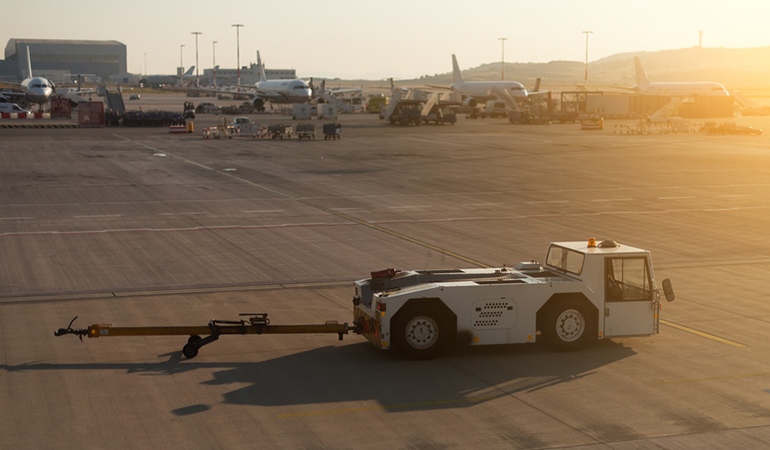Aircraft ground support equipment are pieces of machinery which are designed for specific purposes and do those things generally very well. However, after certain periods of time or due to advances in technology, that machinery becomes outdated or even obsolete. Believe it or not, GSE can impact aircraft operations significantly, both good and bad. Since GSE items are costly, you need to come up with a plan to update your fleet in a way which best supports your operation.
How does GSE become outdated?
So what exactly causes GSE to become outdated or obsolete? What makes an aircraft tug become less proficient at moving a jet just a short distance on a ramp? Doesn’t a diesel generator still produce electrical current just as well now as it did decades ago? To a certain extent, yes. And there are some GSE items which probably will never become obsolete, particularly unpowered GSE such as maintenance stands. With regular servicing and devoid of abusive conditions, these should serve for many decades.
Technology improvements in all areas, particularly in other areas of transportation namely automobiles, push innovation to other related industries. There are a lot of similarities between some segments of GSE and the always-innovative automotive industry. For example, take powered ground units. Major advances in electrical components and electronics now allow similar power output to be provided by much lighter systems than legacy equipment. Some units providing 28V DC power, a standard output for business-class jets and turboprop aircraft, and large turbine helicopters are able to use diesel engines as small as 1.5l which keeps weights 1,000lbs-2,000lbs lighter than legacy equipment.
This translates to anywhere between 25 % – 50 % weight reduction, and a much more compact size. This is extremely important when ground crews are using this equipment all shift long and are often manually pushing and pulling the power unit into position.
Aircraft tow vehicles, commonly referred to as “tugs” have evolved even more radically. In earlier generations, tugs were basically modified farm tractors (sometimes just farm tractors with no modifications), or some other similar platform. They often used industrial engine shared with forklifts or generators, and sometimes even just plain automotive engines. They were simple, very heavy, and built to tow extremely heavy jet aircraft for years and have done a fine job for the most part. But there are some significant drawbacks which are outdating old equipment:
- They burn significant amounts of petroleum, especially when used around the clock.
- Older diesels are notoriously difficult to start in even temperate climates and must be plugged in to block heaters.
- Diesel engines emit a lot of carbon, and must be run for a considerable amount of time to achieve operating temperature. They also are best suited to run for long durations at low operating speeds than to be shut down between uses.
- The two primary operating configurations are not user-friendly or intuitive.
- Tractor tugs which use a metal tow bar require a lot of practice to be proficient in using, practice which must be while pushing an actual aircraft (high liability).
- Towbarless tugs which are manned still require the same crew for a tow as a traditional tug. These are operated either with reciprocating power plants or electrically, but the basic problem remains that all operations require considerable manpower.
Establishing a Model to Replace an Aging Fleet
So where to begin? It really depends on a few things:
- Scope of operation: how many of each type of outdated GSE is currently being utilized, and could that number be reduced by replacing items with more reliable and efficient machinery?
- Frequency of utilization: is the equipment used 24/7? A single shift, five days per week? Once or twice per week? Or is it standby equipment kept on hand just in case it needs to be used?
- Budget: what can the operation afford to replace? And what is the bottom line after repairs, maintenance, time it is out of service and fuel costs?
Scope of Operation
This is an important criteria. The more use equipment gets, the more it requires in maintenance and repair. Also, the more it costs in energy. For instance, the energy used to recharge a battery is likely much less than diesel used if it is being operated around the clock. Conversely, what is the real-world lifecycle per charge? And are the batteries removable for recharging where a replacement can easily be installed, or is it a sealed unit which requires the machinery to be out of service for charging? Climate is very important as well. An electric unit may be better suited for cold environments where it has no warm-up period, but a diesel unit with a heated cab is very nice in that same climate.
Also, you should consider how the tug will be used. For simple push backs from the air bridge or especially into and out of a crowded hangar, a remote controlled tug is an ideal solution. However, if your scope of operation entails towing aircraft long distances across airports using controlled taxiways, especially while exposed to the elements, a more traditional tug might be the best solution.
Frequency of Utilization
Advances in industrial battery design and technology in recent years have produced incredible results in charge usage vice charge times, with a full charge being achieved in as little as three hours and providing anywhere from thirty-to-fifty pushbacks, rivaling many diesel tugs. Duration has been an issue in the past for electric tugs, but this has largely been curtailed.
Budgetary
There is no right or wrong answer here because all organizations are strapped with different financial situations. Regardless of type, brand new GSE is very costly, up to several hundred thousand dollars for large aircraft tugs. Refurbished machinery is available and usually comes with a warranty as if new, along with a substantially reduced price point.
It may be that the best course of action for your organization is to conduct a phased replacement plan which identifies equipment in categories of immediacy. These could be items which are utterly obsolete, items which cost more than their worth in repair and maintenance, or items which are underused or unused because they are inferior.
As long as your GSE has been regularly maintained and serviced, you should be able to resell the items or earn credit as a trade-in. The amount of money that even tired equipment yields is surprising, so long as it is still in good repair.
Other considerations
It may end up that you find the best course of action is to replace part of your fleet and continue to maintain and operate some older machinery. For example, an MRO would be prudent to implement remote control tugs for moving aircraft in and out and around hangars and maintenance docks, while keeping manually driven tugs to transit aircraft across the airport. It will still be a net gain in man hours since a full tow team would no longer be necessary for common movement in and around the hangar.
Some GSE, regardless of tech advances, is simply not going to be able to change all that much. Mobil air conditioning carts will always require huge diesel engines and will always be very heavy and bulky. Dual mode AC/DC power units are not nearly as easy to downsize as their dedicated DC counterparts, so they will also always stay about the same. But aircraft tugs, that’s an area ripe for revolution. Organizations need to determine their ironclad list of needs in GSE, and balance the scales to meet those. In the long run, purchasing the right mix of GSE will end up costing less, and keeping healthy, reliable equipment will cost much less in the long term.
Conclusion to keeping your GSE up to date
There is no right or wrong way to update your GSE needs; you just have to strike a balance between budget, utilization, training, complexity, and time. Purchasing one quality tug far outweighs three unreliable units in the operational environment.
Using a reliable, compact 28V power cart which can be moved by one person or a light utility vehicle is vastly more efficient than a bulky dinosaur which functions erratically and requires a full size truck or several people to move. The people who are on the front lines of the operation will gladly attest to the value of equipment which is easiest to use, simplest to operate, and completely reliable.
Make sure you research what is available vice your legitimate needs; a customer who is coerced into purchasing the wrong thing will not be a repeat customer, and may cost several others in the long run. Most important of all: keep your ground crews in mind first and they will perform their absolute best.
You want to improve your ground handling altogether? Get our comprehensive eBook now for free!



Comments